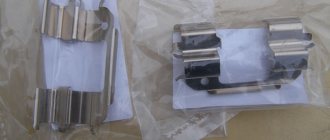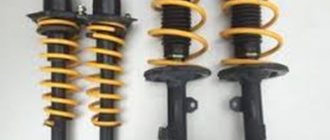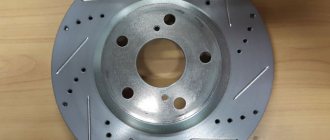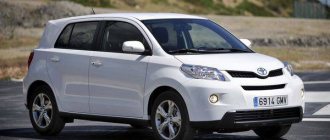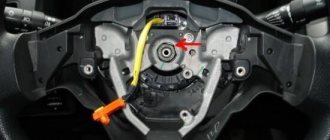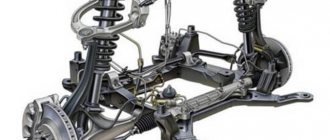Wheel bearings are a part that periodically makes itself felt if it has not been replaced for a long time, or if the car has a defect after an accident associated with the curvature of the front or rear axle, which accelerates the wear process of the bearings.
Toyota Camry XV40 is a series of popular cars, which is nothing more than a descendant of the XV30 series, which was supplied to our country until 2006. The previous model wheel bearings are 100% compatible with the XV40, but the part number is different. There is one subtlety here: with the release of the new model, many spare parts remained the same in their characteristics, but their product numbers were updated.
Thus, on cars of this model, bearings from the KOYO company are installed; they are on sale marked as “Toyota” and under their own logo, and the price for “non-original” ones is lower. Having studied the spare parts website exist.ru, you can find both hub numbers (come with a bearing) for the old and updated car models, respectively: 42460-48010 and 42460-48011. (rear hub numbers are indicated)
Price range
The first thing worth noting regarding the price of hubs and wheel bearings for the Camry 40 and 30 is that they are lower for the old model. It won’t be difficult to find bearings separately, since there is a not very wide, but sufficient pool of manufacturers of parts for Japanese cars. For example, you can pay attention to the company NSK or GMB (Korea).
On average, the price category of bearings without additional parts, such as an o-ring and other components of the so-called “repair kits”, ranges from 1000 to 3000 rubles. An assembled hub, which can be replaced entirely with a bearing, for example, if it wears out, will cost about 5,000-6,000 rubles. You should not look for a cheap way when replacing such an important part, as this can result in dangerous troubles on the road.
What are hub bearings and their purpose
Wheel bearings are devices that allow smooth rotation of a car wheel. Thanks to a well-thought-out design and the use of durable material, they are able to withstand heavy loads.
Due to the presence of bearings, car wheels can operate with little friction. At the same time, they transmit motion from the vehicle axle to its wheel using rolling elements. Wear of these parts can cause unpleasant consequences. To avoid a sad outcome, replacing the Toyota Camry wheel bearing, the price of which is indicated in the price list of the car service.
Difficulties in self-replacement
Both of these car models are equipped with an ABS system, the sensor of which is installed directly in the hub and, if necessary, can be re-soldered without much difficulty (in the case of delivery of the other party’s hub from the store, so as not to exchange goods and not waste time).
For those who change only the bearing, you will definitely need a vice or a special bearing puller in order to remove the part as carefully as possible and not damage the hub, and also to install the new one smoothly.
In general, replacing such a part on your own is not complicated by anything other than the need to use a puller, however, if the experience of carrying out such work does not inspire confidence before the upcoming repair, then you should contact specialists who will replace one bearing in 30 minutes maximum.
Toyota Camry front wheel hub repair
Remove the front wheel. Using special tool 09930-00010, unscrew the front wheel hub nut
Disconnect the front speed sensor.
After unscrewing the 2 mounting bolts, disconnect the front disc brake caliper from the steering knuckle (Fig. 1).
Remove the front disc.
Using special tool 09628-62011, disconnect the left tie rod.
Disconnect the front suspension lower arm.
Using a plastic hammer, separate the front wheel drive assembly from the front wheel hub. Be careful not to damage the ABS speed sensor boot and rotor.
Unscrew the 2 bolts and nuts and remove the steering knuckle with the front wheel hub (Fig. 2).
Unscrew the cotter pin and nut.
Using special tool 09628-62011, remove the lower ball joint of the front suspension (Fig. 3).
Using a snap ring remover, remove the left drive shaft inner joint snap ring (Figure 4).
Using special tool 09520-00031, remove the front wheel hub (Fig. 5).
Using special tool 09950-00020 and a press, remove the inner ring (outside) of the front wheel hub (Fig. 6).
Using a Torx (T30) wrench, remove the 4 bolts and disc brake guard.
Place the inner race (outside) onto the front wheel hub bearing.
Using special tool 09527-17011 and a press, press out the front wheel hub bearing until it stops in the special tool (Fig. 7).
Using a wrench to install the steering knuckle horizontally, install it on the stand as shown in Figure 8.
Make sure the steering knuckle is horizontal.
Using special tool 09950-60010 and a press, press out the wheel bearing.
INSTALLATION
Using special tool 09950-60020 and a press, install the new front wheel hub bearing into the steering knuckle.
Install the disc brake guard and use a Torx wrench (T30) to tighten the 4 bolts.
Using a special tool and a press, install the front wheel hub (Fig. 10)
Using a circlip installer, install a new circlip for the front wheel hub bore.
Install the front suspension lower ball joint and tighten the nut. Tightening torque: 123 Nm.
Install a new cotter pin.
If the cotter pin holes do not line up, tighten the nut further to 60°.
Install the 2 bolts, nuts and front hub assembly to the front shock absorber strut.
Tightening torque: 210 Nm.
Insert the bolt from the front of the vehicle and tighten the nut.
Slide the front hub out, align the front wheel drive spline with the hole in the hub, and insert the front wheel drive into the hub.
Don't push the front hub too far
.
Be careful not to damage the outer joint cover.
Be careful not to damage the ABS speed sensor rotor.
Install the No. 1 front suspension lower arm.
Install the tie rod.
Install the front disc.
Install the disc brake caliper and secure it with two bolts to the steering knuckle. Tightening torque: 106.9 Nm.
Install the front wheel hub nut.
Disconnect the disc brake caliper and check the wheel bearing clearance and other checks.
Finally install the disc brake caliper onto the steering knuckle and secure it with 2 bolts.
Install the front speed sensor.
Install the front wheel. Tightening torque: 103 Nm.
Check and adjust the front wheel alignment angles.
Check the ABS speed sensor signal.
Sequence of actions when replacing a wheel bearing
The step-by-step instructions consist of 16 steps, the last of which is installing the repaired hub with a new bearing on the car.
- So, first you need to hang the wheel using a jack or lift it on a lift.
- Remove the wheel.
- Remove the brake caliper.
- Remove the brake disc.
- For the rear wheel, it will be typical to remove the handbrake pads.
- The hub itself is unscrewed directly through the holes in the hub.
- Use a slotted screwdriver or any thin flat tool to remove the locking burr on the locknut.
- Remove the oil seal.
- The old bearing is pressed out using a puller.
- The inner bearing race will also need to be removed from the hub if it remains there.
- The seat must be checked visually for wear and must be cleaned of dirt and old grease by rinsing it with a solvent.
- Before installing the bearing, you need to lubricate the seat with lithol/solidol.
- The first thing to install is the O-ring (!)
- Next, the bearing itself is pressed into the race and onto the hub; you need to tighten the nut and lock it immediately - at this stage you must not allow it to fit unevenly into the race and hub (!)
- Before installing the updated hub on the car, the oil seal is returned to its place (or a new one is installed).
- As was said, the entire part is placed on the car and then the remaining elements are assembled in place in the reverse order of disassembly.
There are no fundamental differences in replacing the front and rear bearings, since the design of the hubs differs only in the presence of parking brake pads on the rear axle.
What affects bearing performance?
Operating a car on flat tires or low-profile tires has a negative impact on the service life of the hub. The fact is that such wheels practically do not absorb shock loads that occur when driving over uneven surfaces. And first of all, the wheel hub suffers from this.
What affects bearing performance?
Second in the ranking of probable causes of bearing failure is wheel camber/alignment problems. Wheels located at an angle lead to a manifold increase in the loads transmitted to the hub, which affects the bearings. This is usually true for the front axle, in which, due to the design features of the suspension, violation of the camber/toe angle occurs regularly.
How to choose a bearing
It is worth noting that the hub is non-separable, and bearing replacement is not officially carried out. If it fails, the entire hub is replaced, with the bearing installed inside. But in fact, everything is much simpler - replacing the front wheel bearing on a Camry , as well as the rear one, is carried out without any difficulties. Today, there are many original parts and duplicates of varying quality on sale, manufactured in European and Asian countries.
It is recommended to purchase only original spare parts: as practice has shown, their service life is much longer than that of their analogues. As an alternative to a new non-original part, you can buy a contract hub assembly - its cost is usually significantly lower than the price of the bearing, but no one will provide a guarantee for its operation.
How to choose a bearing
To purchase a part, you need the body number or VIN of the car - this data must be provided to the car dealer.




